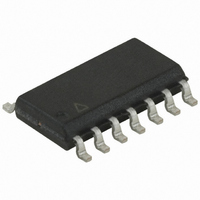ATTINY24-15SSZ Atmel, ATTINY24-15SSZ Datasheet - Page 123

ATTINY24-15SSZ
Manufacturer Part Number
ATTINY24-15SSZ
Description
MCU AVR 2K FLASH 15MHZ 14-SOIC
Manufacturer
Atmel
Series
AVR® ATtinyr
Datasheet
1.ATTINY24-15SSZ.pdf
(225 pages)
Specifications of ATTINY24-15SSZ
Package / Case
14-SOIC (3.9mm Width), 14-SOL
Voltage - Supply (vcc/vdd)
2.7 V ~ 5.5 V
Operating Temperature
-40°C ~ 125°C
Speed
16MHz
Number Of I /o
12
Eeprom Size
128 x 8
Core Processor
AVR
Program Memory Type
FLASH
Ram Size
128 x 8
Program Memory Size
2KB (2K x 8)
Data Converters
A/D 8x10b
Oscillator Type
Internal
Peripherals
Brown-out Detect/Reset, POR, PWM, WDT
Connectivity
USI
Core Size
8-Bit
Cpu Family
ATtiny
Device Core
AVR
Device Core Size
8b
Frequency (max)
16MHz
Interface Type
SPI/UART
Total Internal Ram Size
128Byte
# I/os (max)
12
Number Of Timers - General Purpose
2
Operating Supply Voltage (typ)
3.3/5V
Operating Supply Voltage (max)
5.5V
Operating Supply Voltage (min)
2.7V
On-chip Adc
8-chx10-bit
Instruction Set Architecture
RISC
Operating Temp Range
-40C to 125C
Operating Temperature Classification
Automotive
Mounting
Surface Mount
Pin Count
14
Package Type
SOIC
Lead Free Status / RoHS Status
Lead free / RoHS Compliant
Available stocks
Company
Part Number
Manufacturer
Quantity
Price
Company:
Part Number:
ATTINY24-15SSZ
Manufacturer:
ATMEL
Quantity:
349
Part Number:
ATTINY24-15SSZ
Manufacturer:
ATTINY
Quantity:
20 000
- Current page: 123 of 225
- Download datasheet (4Mb)
7701D–AVR–09/10
Figure 16-3. Three-wire Mode, Timing Diagram
The Three-wire mode timing is shown in
USCK cycle reference. One bit is shifted into the USI shift register (USIDR) for each of these
cycles. The USCK timing is shown for both external clock modes. In external clock mode 0
(USICS0 = 0), DI is sampled at positive edges, and DO is changed (data register is shifted by
one) at negative edges. External clock mode 1 (USICS0 = 1) uses the opposite edges versus
mode 0, i.e., it samples data at negative edges and changes the output at positive edges. The
USI clock modes correspond to the SPI data mode 0 and 1.
Referring to the timing diagram
ing steps:
1. The slave device and master device set up their data output and, depending on the
2. The Master generates a clock pulse by software toggling the USCK line twice (C and
3. Step 2 is repeated eight times for a complete register (byte) transfer.
4. After eight clock pulses (i.e., 16 clock edges), the counter will overflow and indicate that
protocol used, enable their output driver (mark A and B). The output is set up by writing
the data to be transmitted to the serial data register. Enabling of the output is done by
setting the corresponding bit in the port data direction register. Note that points A and B
do not have any specific order, but both must be at least one half USCK cycle before
point C, where the data are sampled. This must be done to ensure that the data setup
requirement is satisfied. The 4-bit counter is reset to zero.
D). The bit value on the slave and master’s data input (DI) pin is sampled by the USI on
the first edge (C), and the data output is changed on the opposite edge (D). The 4-bit
counter will count both edges.
the transfer is completed. The data bytes transferred must now be processed before a
new transfer can be initiated. The overflow interrupt will wake up the processor if it is
set to idle mode. Depending on the protocol used, the slave device can now set its out-
put to high impedance.
CYCLE
USCK
USCK
DO
DI
( Reference )
A
B
MSB
MSB
C
1
Atmel ATtiny24/44/84 [Preliminary]
D
2
6
6
(Figure 16-3 on page
3
5
5
Figure 16-3 on page
4
4
4
123), a bus transfer involves the follow-
5
3
3
6
123. At the top of the figure is a
2
2
7
1
1
LSB
LSB
8
E
123
Related parts for ATTINY24-15SSZ
Image
Part Number
Description
Manufacturer
Datasheet
Request
R

Part Number:
Description:
Manufacturer:
Atmel Corporation
Datasheet:

Part Number:
Description:
Manufacturer:
Atmel Corporation
Datasheet:

Part Number:
Description:
IC MCU AVR 2K FLASH 20MHZ 20-QFN
Manufacturer:
Atmel
Datasheet:

Part Number:
Description:
IC MCU AVR 2K FLASH 20MHZ 14SOIC
Manufacturer:
Atmel
Datasheet:

Part Number:
Description:
MCU AVR 2K FLASH 15MHZ 20-QFN
Manufacturer:
Atmel
Datasheet:

Part Number:
Description:
IC MCU AVR 2K FLASH 20MHZ 14-DIP
Manufacturer:
Atmel
Datasheet:

Part Number:
Description:
MCU AVR 2KB FLASH 20MHZ 14SOIC
Manufacturer:
Atmel
Datasheet:

Part Number:
Description:
MCU AVR 2KB FLASH 20MHZ 20QFN
Manufacturer:
Atmel
Datasheet:

Part Number:
Description:
IC, MCU, 8BIT, 2K FLASH, 20SOIC
Manufacturer:
Atmel
Datasheet:

Part Number:
Description:
IC, MCU, 8BIT, 2K FLASH, 20PDIP
Manufacturer:
Atmel
Datasheet:

Part Number:
Description:
IC, MCU, 8BIT, 8K FLASH, 20PDIP
Manufacturer:
Atmel
Datasheet:

Part Number:
Description:
IC, MCU, 8BIT, 8K FLASH, 20SOIC
Manufacturer:
Atmel
Datasheet:











